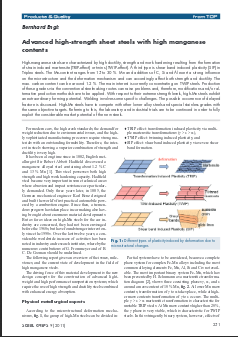High-manganese steels are characterized by high ductility, strength and work hardening resulting from the formation of strain induced martensite (TRIP-effect) or twins (TWIP-effect). A third type is shear band induced plasticity (SIP) in Triplex steels. The Mn-content ranges from 15 to 30 %. Mn and additions of C, Si and Al exert a strong influence on the microstructure and the deformation mechanism and can accordingly affect both strength and ductility. The max. carbon content can be around 1.2 %. The main interest is currently concentrating on TWIP steels. Production of these grades via the conventional steelmaking routes can raise problems and, therefore, modifications and/or alternative production methods have to be applied. With respect to their extreme strength levels, high-Mn steels exhibit an extraordinary forming potential. Welding involves some specific challenges. The possible occurrence of delayed fracture is discussed. High-Mn steels have to compete with other lower alloy steels and special stainless grades with the same objective targets. Referring to this, the laboratory and industrial trials are to be continued in order to fully exploit the considerable market potential of the new steels.
Advanced high-strength sheet steels with high manganese contents

